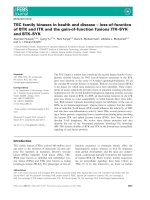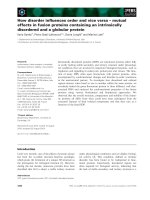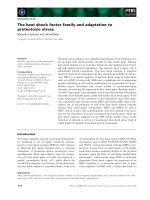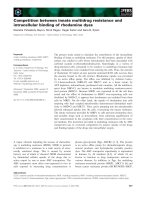Tài liệu Báo cáo khoa học: "How Are Spelling Errors Generated and Corrected? " docx
Bạn đang xem bản rút gọn của tài liệu. Xem và tải ngay bản đầy đủ của tài liệu tại đây (1.29 MB, 5 trang )
Proceedings of the 50th Annual Meeting of the Association for Computational Linguistics, pages 373–377,
Jeju, Republic of Korea, 8-14 July 2012.
c
2012 Association for Computational Linguistics
How Are Spelling Errors Generated and Corrected? A Study of Corrected
and Uncorrected Spelling Errors Using Keystroke Logs
Yukino Baba
The University of Tokyo
Hisami Suzuki
Microsoft Research
Abstract
This paper presents a comparative study of
spelling errors that are corrected as you type,
vs. those that remain uncorrected. First,
we generate naturally occurring online error
correction data by logging users’ keystrokes,
and by automatically deriving pre- and post-
correction strings from them. We then per-
form an analysis of this data against the errors
that remain in the final text as well as across
languages. Our analysis shows a clear distinc-
tion between the types of errors that are gen-
erated and those that remain uncorrected, as
well as across languages.
1 Introduction
When we type text using a keyboard, we generate
many spelling errors, both typographical (caused by
the keyboard layout and hand/finger movement) and
cognitive (caused by phonetic or orthographic sim-
ilarity) (Kukich, 1992). When the errors are caught
during typing, they are corrected on the fly, but un-
noticed errors will persist in the final text. Previ-
ous research on spelling correction has focused on
the latter type (which we call uncorrected errors),
presumably because the errors that are corrected on
the spot (referred to here as corrected errors) are
not recoded in the form of a text. However, study-
ing corrected errors is important for at least three
reasons. First, such data encapsulates the spelling
mistake and correction by the author, in contrast
to the case of uncorrected errors in which the in-
tended correction is typically assigned by a third
person (an annotator), or by an automatic method
(Whitelaw et al., 2009; Aramaki et al., 2010)
1
. Sec-
ondly, data on corrected errors will enable us to build
a spelling correction application that targets correc-
tion on the fly, which directly reduces the number of
keystrokes in typing. This is crucial for languages
that use transliteration-based text input methods,
such as Chinese and Japanese, where a spelling error
in the input Roman keystroke sequence will prevent
1
Using web search query logs is one notable exception,
which only targets spelling errors in search queries (Gao et al.,
2010)
Keystroke
missspell
misspell
Pre-correction strings
Post-correction strings
m - i - s - s - s - p - BACKSPACE - BACKSPACE - p - e - l - l
Figure 1: Example of keystroke
the correct candidate words from appearing in the
list of candidates in their native scripts, thereby pre-
venting them from being entered altogether. Finally,
we can collect a large amount of spelling errors and
their corrections by logging keystrokes and extract-
ing the pre- and post-correction strings from them.
By learning the characteristics of corrected and un-
corrected errors, we can expect to use the data for
improving the correction of the errors that persisted
in the final text as well.
In this paper, we collect naturally occurring
spelling error data that are corrected by the users
online from keystroke logs, through the crowd-
sourcing infrastructure of Amazon’s Mechanical
Turk (MTurk). As detailed in Section 3, we dis-
play images to the worker of MTurk, and collect
the descriptions of these images, while logging their
keystrokes including the usage of backspace keys,
via a crowd-based text input service. We collected
logs for two typologically different languages, En-
glish and Japanese. An example of a log along
with the extracted pre- and post-correction strings
is shown in Figure 1. We then performed two com-
parative analyses: corrected vs. uncorrected errors
in English (Section 4.3), and English vs. Japanese
corrected errors (Section 4.4). Finally, we remark
on an additional cause of spelling errors observed in
all the data we analyzed (Section 4.5).
2 Related Work
Studies on spelling error generation mechanisms are
found in earlier work such as Cooper (1983). In
particular, Grudin (1983) offers a detailed study of
the errors generated in the transcription typing sce-
nario, where the subjects are asked to transcribe a
text without correcting the errors they make. In a
more recent work, Aramaki et al. (2010) automati-
cally extracted error-correction candidate pairs from
Twitter data based on the assumption that these pairs
373
fall within a small edit distance, and that the errors
are not in the dictionary and substantially less fre-
quent than the correctly spelled counterpart. They
then studied the effect of five factors that cause er-
rors by building a classifier that uses the features as-
sociated with these classes and running ablation ex-
periments. They claim that finger movements cause
the spelling errors to be generated, but the uncor-
rected errors are characterized by visual factors such
as the visual similarity of confused letters. Their ex-
periments however target only the persisted errors,
and their claim is not based on the comparison of
generated and persisted errors.
Outside of English, Zheng et al. (2011) analyzed
the keystroke log of a commercial text input system
for Simplified Chinese, and compared the error pat-
terns in Chinese with those in English. Their use of
the keystroke log is different from ours in that they
did not directly log the input in pinyin (Romanized
Chinese by which native characters are input), but
the input pinyin sequences are recovered from the
Chinese words in the native script (hanzi) after the
character conversion has already applied.
3 Keystroke Data Collection
Amazon’s Mechanical Turk (MTurk) is a web ser-
vice that enables crowdsourcing of tasks that are dif-
ficult for computers to solve, and has become an im-
portant infrastructure for gathering data and annota-
tion for NLP research in recent years (Snow et al.
2008). To the extent of our knowledge, our work
is the first to use this infrastructure to gather user
keystroke data.
3.1 Task design
In order to collect naturally occurring keystrokes,
we have designed two types of tasks, both of which
consist of writing something about images. In one
task type, we asked the workers to write a short
description of images (image description task); in
the other, the workers were presented with im-
ages of a person or an animal, and were asked to
guess and type what she/he was saying (let-them-
talk task). Using images as triggers for typing keeps
the underlying motivation of keystroke collection
hidden from the workers, simultaneously allowing
language-independent data collection. For the im-
age triggers, we used photos from the Flickr’s Your
Best Shot 2009/2010 groups . Examples of the tasks
and collected text are given in Figure 2.
「ペンギンの群れが雪の中を行進しています。」
「お母さん、足つかへん。」
Image Description Task Let-them-talk Task
”oh mummy. please dont take a clip. i
am naked and i feel shy. at least give
me a towel.”
En
“A flock of penguins waddle towards
two trees over snow covered ground.”
Ja
En
Ja
Figure 2: Examples of tasks and collected text (Translated text:
“A flock of penguines are marching in the snow.” and “Mummy,
my feet can’t touch the bottom.”)
3.2 Task interface
For logging the keystrokes including the use of
backspaces, we designed an original interface for the
text boxes in the MTurk task. In order to simplify
the interpretation of the log, we disabled the cursor
movements and text highlighting via a mouse or the
arrow keys in the text box; the workers are therefore
forced to use the backspace key to make corrections.
In Japanese, many commercially available text in-
put methods (IMEs) have an auto-complete feature
which prevents us from collecting all keystrokes for
inputting a word. We therefore used an in-house
IME that has disabled this feature to collect logs.
This IME is hosted as a web service, and keystroke
logs are also collected through the service. For En-
glish, we used the service for log collection only.
4 Keystroke Log Analysis
4.1 Data
We used both keystroke-derived and previously
available error data for our analysis.
Keystroke-derived error pairs for English and
Japanese (en keystroke, ja keystroke): from the
raw keystroke logs collected using the method de-
scribed in Section 3, we extracted only those words
that included a use of the backspace key. We then
recovered the strings before and after correction by
the following steps (Cf. Figure 1):
• To recover the post-correction string, we
deleted the same number of characters preced-
ing a sequence of backspace keys.
• To recover the pre-correction string, we com-
pared the prefix of the backspace usage
(misssp in Figure 1) with the substrings
after error correction (miss, missp, ···,
misspell), and considered that the prefix
was spell-corrected into the substring which is
the longest and with the smallest edit distance
374
(in this case, misssp is an error for missp,
so the pre-correction string is missspell).
We then lower-cased the pairs and extracted only
those within the edit distance of 2. The resulting data
which we used for our analysis consists of 44,104
pairs in English and 4,808 pairs in Japanese
2
.
Common English errors (en common): follow-
ing previous work (Zheng et al., 2011), we ob-
tained word pairs from Wikipedia
3
and SpellGood
4
.
We lower-cased the entries from these sources, re-
moved the duplicates and the pairs that included
non-Roman alphabet characters, and extracted only
those pairs within the edit distance of 2. This left us
with 10,608 pairs.
4.2 Factors that affect errors
Spelling errors have traditionally been classified into
four descriptive types: Deletion, Insertion, Substitu-
tion and Transposition (Damerau, 1964). For each
of these types, we investigated the potential causes
of error generation and correction, following previ-
ous work (Aramaki et al., 2010; Zheng et al., 2011).
Physical factors: (1) motor control of hands and fin-
gers; (2) distance between the keys; Visual factors:
(3) visual similarity of characters; (4) position in
a word; (5) same character repetition; Phonologi-
cal factors: (6) phonological similarity of charac-
ters/words.
In what follows, our discussion is based on the
frequency ratio of particular error types, where the
frequency ratio refers to the number of cases in
spelling errors divided by the total number of cases
in all data. For example, the frequency ratio of con-
sonant deletion is calculated by dividing the number
of missing consonants in errors by the total number
of consonants.
4.3 Corrected vs. uncorrected errors in English
In this subsection, we compare corrected and uncor-
rected errors of English, trying to uncover what fac-
tors facilitate the error correction.
Error types (Figure 3) Errors in en keystroke are
dominated by Substitution, while Deletion errors are
the most common in en common, indicating that
2
The data is available for research purposes under http:
//research.microsoft.com/research/downloads/
details/4eb8d4a0-9c4e-4891-8846-7437d9dbd869/
details.aspx
3
/>Lists of common misspellings/For machines
4
/>ja_keystroke
en_keystroke
en_common
Deletion
Insertion
Substitution
Transposition
Ratio (%)
0 20 40 60 80 100
Figure 3: Ratios of error types
Substition
Similarity
Freq.
0.000
Similarity
Freq.
0.000
Similarity
Freq.
0.000
0.30 0.90
0.30 0.90
0.30 0.90
en_keystroke ja_keystrokeen_common
Figure 4: Visual similarities
of characters in substitution
errors
0 20 40 60 80 100
Deletion
0−base position / (word length−1) (%)
Density
0 20 40 60 80 100
Insertion
0−base position / (word length−1) (%)
Density
0 20 40 60 80 100
Substitution
0−base position / (word length−1) (%)
Density
0 20 40 60 80 100
Transposition
0−base position / (word length−1) (%)
Density
en_keystroke ja_keystrokeen_common
Figure 5: Positions of errors within words
Substitution mistakes are easy to catch, while Dele-
tion mistakes tend to escape our attention. Zheng
et al. (2011) reports that their pinyin correction er-
rors are dominated by Deletion, which suggests that
their log does in fact reflect the characteristics of cor-
rected errors.
Position of error within a word (Figure 5) In
en keystroke, Deletion errors at the word-initial po-
sition are the most common, while Insertion and
Substitution errors tend to occur both at the be-
ginning and the end of a word. In contrast, in
en common, all error types are more prone to oc-
cur word-medially. This means that errors at word
edges are corrected more often than the word-
internal errors, which can be attributed to cognitive
effect known as the bathtub effect (Aitchison, 1994),
which states that we memorize words at the periph-
ery most effectively in English.
Effect of character repetition (Figure 6) Dele-
tion errors where characters are repeated, as in
tomorow→tomorrow, is observed significantly
more frequently than in a non-repeating context in
en common, but no such difference is observed in
en keystroke, showing that visually conspicuous er-
rors tend to be corrected.
Visual similarity in Substitution errors (Figure
4) We computed the visual similarity of characters
by
2×(the area of overlap between character A and B)/
(area of character A+area of character B) follow-
375
Not Repeated / Repeated
Deletion
Ratio of Freq.
0.0 0.4 0.8
en_keystroke ja_keystrokeen_common
Figure 6: Effect of character
repetition in Deletion
0.0 0.4 0.8
en_keystroke ja_keystrokeen_common
Diff=2 / Diff=1
Transposition
Ratio of Freq.
Figure 7: Difference of posi-
tions within words in Trans-
position
Vowel / Consonant
Insertion
Inserted Character
0.0 0.4 0.8
C−>C C−>V V−>C V−>V
Substitution
Substituted Character −> Correct Character
en_keystroke ja_keystrokeen_common
Freq./max(Freq.)
0.0 0.4 0.8
Ratio of Freq.
Figure 8: Consonants/vowels in Insertion and Substitution
ing Aramaki et al. (2010)
5
. Figure 4 shows that in
en common, Substitution errors of visually similar
characters (e.g., yoqa→yoga) are in fact very
common, while in en keystroke, no such tendency
is observed.
Phonological similarity in Substitution errors
(Figure 8) In en keystroke, there is no notable
difference in consonant-to-consonant (C→C) and
vowel-to-vowel (V→V) errors, but in en common,
V→V errors are overwhelmingly more com-
mon, suggesting that C→C can easily be no-
ticed (e.g., eazy→easy) while V→V errors (e.g.,
visable→visible) are not. This tendency is
consistent with the previous work on the cognitive
distinction between consonants and vowels in En-
glish: consonants carry more lexical information
than vowels (Nespor et al., 2003), a claim also
supported by distributional evidence (Tanaka-Ishii,
2008). It may also be attributed to the fact that En-
glish vowel quality is not always reflected by the on-
thography in the straightforward maner.
Summarizing, we have observed both visual and
phonological factors affect the correction of errors.
Aramaki et al. (2010)’s experiments did not show
that C/V distinction affect the errors, while our data
shows that it does in the correction of errors.
4.4 Errors in English vs. Japanese
From Figure 3, we can see that the general error
pattern is very similar between en keystroke and
ja keystroke. Looking into the details, we discov-
ered some characteristic errors in Japanese, which
are phonologically and orthographically motivated.
Syllable-based transposition errors (Figure 7)
When comparing the transposition errors by their
5
We calculated the area using the Courier New font which
we used in our task interface.
Appeared Before To Appear
Substitution
Substituted Character
Freq. / max(Freq.)
0.0 0.4 0.8
Not Appeared Before Not to Appear
en_keystroke ja_keystrokeen_common
Figure 9: Look-ahead and Look-behind in Substitution
distance, 1 being a transposition of adjacent char-
acters and 2 a transposition skipping a character, the
instances in en keystroke are mostly of distance of
1, while in ja keystroke, the distance of 2 also occurs
commonly (e.g., kotoro→tokoro). This is inter-
esting, because the Japanese writing system called
kana is a syllabary system, and our data suggests that
users may be typing a kana character (typically CV)
as a unit. Furthermore, 73% of these errors share
the vowel of the transposed syllables, which may be
serving as a strong condition for this type of error.
Errors in consonants/vowels (Figure 8) Errors
in ja keystroke are characterized by a smaller ra-
tio of insertion errors of vowels relative to conso-
nants, and by a relatively smaller ratio of V→V sub-
stitution errors. Both point to the relative robust-
ness of inputting vowels as opposed to consonants
in Japanese. Unlike English, Japanese only has five
vowels whose pronunciations are transparently car-
ried by the orthography; they are therefore expected
to be less prone to cognitive errors.
4.5 Look-ahead and look-behind errors
In Substitution errors for all data we analyzed, sub-
stituting for the character that appeared before, or
are to appear in the word was common (Figure
9). In particular, in en keystroke and ja keystroke,
look-ahead errors are much more common than non-
look-ahead errors. Grudin (1983) reports cases
of permutation (e.g., gib→big) but our data in-
cludes non-permutation look-ahead errors such as
puclic→public and otigaga→otibaga.
5 Conclusion
We have presented our collection methodology and
analysis of error correction logs across error types
(corrected vs. uncorrected) and languages (English
and Japanese). Our next step is to utilize the col-
lected data and analysis results to build online and
offline spelling correction models.
Acknowledgments
This work was conducted during the internship of
the first author at Microsoft Research. We are grate-
ful to the colleagues for their help and feedback in
conducting this research.
376
References
Aitchison, J. 1994. Words in the Mind. Blackwell.
Aramaki, E., R. Uno and M. Oka. 2010. TYPO Writer:
ヒトはどのように打ち間違えるのか? (TYPO
Writer: how do humans make typos?). In Proceedings
of the 16th Annual Meeting of the Natural Language
Society (in Japanese).
Cooper, W. E. (ed.) 1983. Cognitive Aspects of Skilled
Typewriting. Springer-Verlag.
Damerau, F. 1964. A technique for computer detection
and correction of spelling errors. Communications of
the ACM 7(3): 659-664.
Gao, J., X. Li, D. Micol, C. Quirk and X. Sun. 2010.
A large scale ranker-based system for search query
spelling correction. In Proceedings of COLING.
Grudin, J. T. 1983. Error patterns in novice and skilled
transcription typing. In Cooper, W.E. (ed.), Cognitive
Aspects of Skilled Typewriting. Springer-Verlag.
Kukich, K. 1992. Techniques for automatically correct-
ing words in text. In ACM Computing Surveys, 24(4).
Nespor, M., M. Pe
˜
na, and J. Mehler. 2003. On the differ-
ent roles of vowels and consonants in speech process-
ing and language acquisition. Lingue e Linguaggio,
pp. 221―247.
Snow, R., B. O’Connor, D. Jurafsky, and A. Ng. 2008.
Cheap and fast – but is it good?: evaluating non-expert
annotations for natural language tasks. In Proceedings
of EMNLP.
Tanaka-Ishii, K. 2008. 単語に内在する情報量の偏在
(On the uneven distribution of information in words).
In Proceedings of the 14th Annual Meeting of the Nat-
ural Language Society (in Japanese).
Whitelaw, Casey, Ben Hutchinson, Grace Y. Chung, and
Gerard Ellis. 2009. Using the web for language in-
dependent spellchecking and autocorrection. In Pro-
ceedings of ACL.
Zheng, Y., L. Xie, Z. Liu, M. Sun. Y. Zhang and L. Ru
2011. Why press backspace? Understanding user in-
put behaviors in Chinese pinyin input method. In Pro-
ceedings of ACL
377









